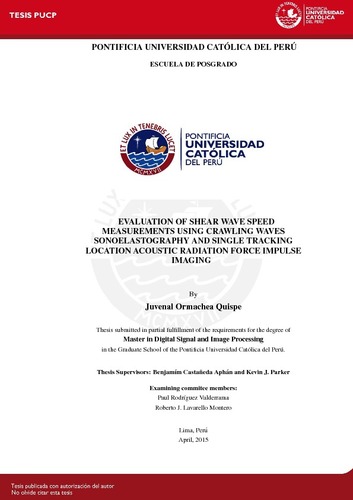| dc.contributor.advisor | Castañeda Aphan, Benjamín | |
| dc.contributor.advisor | Parker, Kevin J. | |
| dc.contributor.author | Ormachea Quispe, Juvenal | es_ES |
| dc.date.accessioned | 2015-07-25T13:46:27Z | es_ES |
| dc.date.available | 2015-07-25T13:46:27Z | es_ES |
| dc.date.created | 2015 | es_ES |
| dc.date.issued | 2015-07-25 | es_ES |
| dc.identifier.uri | http://hdl.handle.net/20.500.12404/6195 | |
| dc.description.abstract | Many pathological conditions are closely related with an increase in tissue sti ness.
For many years, experts performed manual palpation in order to measure elasticity changes, however, this method can only be applied on superficial areas of the human body and provides crude sti ness estimation. Elastography is a technique that attempts to characterize the elastic properties of tissue in order to provide additional and useful information for clinical diagnosis. For more than twenty years, di erent research groups have developed various elastography modalities with a strong interest for quantitative images during the last decade.
Recently, comparative studies among di erent elastographic techniques have been performed in order to better characterize biomaterials, to cross-validate several shear wave elastographic modalities and to study the factors that influence their precision and accuracy.
This comparison works may contribute to achieve standardization in quantitative elastography and their use in commercial equipment for their application in human patients. However, there is still a limited literature in the field of quantitative elastography modalities comparisons.
This thesis focuses on the comparison between two elastographic techniques: crawling
wave sonoelastography (CWS) and single tracking location-acoustic radiation force impulse (STL-ARFI). The comparison shows the estimation of the shear wave speed (SWS), lateral resolution, contrast and contrast-to-noise ratio (CNR) in homogeneous and inhomogeneous phantoms using both techniques. The SWS values obtained with both modalities are validated with mechanical measurements that are considered as ground truth. The SWS results for the three di erent homogeneous phantoms (10%, 13%, and 16% gelatin concentrations), show good agreement between CWS, STL-ARFI and mechanical measurements as a function of frequency. The maximum accuracy errors obtained with CWS were 2.52%, 1.63% and 2.26%. For STL-ARFI, the maximum errors were 6.22%, 5.63% and 4.08% for the 10%,13% and 16% gelatin phantom respectively. For lateral resolution, contrast and CNR estimated in the inhomogeneous phantoms, it can be seen that for vibration frequencies higher than 340 Hz, CWS presents better results than the obtained with STL-ARFI using distances between the push beams ( x) higher than 4 mm. However, using these vibration frequencies will not be feasible for in vivo tissues due to attenuation problems. It that sense, for lower vibration frequencies than 300 Hz and x among 3 mm and 6 mm, comparable lateral resolution, contrast and CNR was obtained. Finally, the results of this study contribute to the data currently available for comparing elastographic techniques. Moreover, the methodology implemented in this document may be helpful for future standardization
for di erent elastographic modalities. | es_ES |
| dc.description.uri | Tesis | es_ES |
| dc.language.iso | spa | es_ES |
| dc.publisher | Pontificia Universidad Católica del Perú | es_ES |
| dc.rights | info:eu-repo/semantics/openAccess | es_ES |
| dc.rights.uri | http://creativecommons.org/licenses/by-nc-nd/2.5/pe/ | * |
| dc.subject | Acústica--Ondas | es_ES |
| dc.subject | Ondas sonoras--Fuentes de radiación | es_ES |
| dc.subject | Ultrasonido | es_ES |
| dc.title | Evaluation of shear wave speed measurements using crawling waves sonoelastography and single tracking location acoustic radiation force impulse imaging | es_ES |
| dc.type | info:eu-repo/semantics/masterThesis | es_ES |
| thesis.degree.name | Maestro en Procesamiento de señales e imágenes digitales | es_ES |
| thesis.degree.level | Maestría | es_ES |
| thesis.degree.grantor | Pontificia Universidad Católica del Perú. Escuela de Posgrado | es_ES |
| thesis.degree.discipline | Procesamiento de señales e imágenes digitales | es_ES |
| renati.advisor.dni | 10791304 | |
| renati.discipline | 613077 | es_ES |
| renati.level | https://purl.org/pe-repo/renati/level#maestro | es_ES |
| renati.type | http://purl.org/pe-repo/renati/type#tesis | es_ES |
| dc.publisher.country | PE | es_ES |
| dc.subject.ocde | https://purl.org/pe-repo/ocde/ford#2.02.05 | es_ES |






